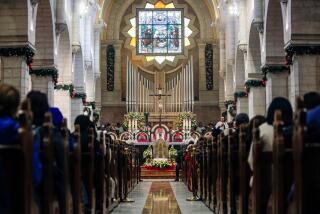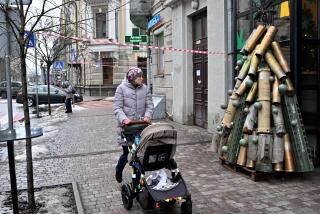A Greeting With Meaning
The holiday greeting from the White House told the grievous story: Save for a slim red border at the bottom, the card was winter white, with no hint of color or Christmas, and embossed only with a stark U.S. seal: a bald eagle encircled by stars. On the inside, President Lyndon B. Johnson and the first lady’s printed message was for a happy new year and either “a Blessed Christmas” or “Season’s Greetings.”
The new president and Lady Bird Johnson sent the cards in December 1963, the month of official mourning following the Nov. 22 assassination of John F. Kennedy, said Mary Evans Seeley, author of “Season’s Greetings From the White House: The Collection of Presidential Christmas Cards, Messages and Gifts” (1996). In a memo dated five days after Kennedy’s death, the State Department’s chief of protocol had recommended that the Johnsons extend the holiday greetings; their limited Christmas card list included government leaders in the U.S. and abroad.
Thirty-eight years later, George W. and Laura Bush have vowed to mail hundreds of thousands of cards, keeping with a presidential tradition unbroken by war or other national crises since Herbert Hoover in 1929, according to Seeley’s records. But this season, Americans--including President Bush and the first lady--are rethinking the once-routine matter of holiday cards: Given the proximity to the Sept. 11 terrorist attacks, what kind of end-of-the-year greeting is appropriate? And given fears of anthrax contamination, as remote as it may be, what is the best way to send the cards?
In the last 100-plus years, holiday cards have been used in some circles to send a statement--supporting recycled paper products, for instance, or a charitable cause--or a snapshot of the times, whether it be the somber mood of a nation following the slaying of a U.S. president or a proud portrait of a World War I doughboy infantryman.
The Bushes’ 2001 card will include a change that points to how even the minutiae of holiday ritual are not immune to reverberations from the terrorist attacks. Recently, according to the first lady’s press office, Mrs. Bush decided to change the Bible verse on their cards to one with a more appropriate tone. She won’t reveal her original choice, but the message inside the card now reads: “Thy face, Lord, do I seek: I believe that I shall see the goodness of the Lord in the land of the living!”--Psalm 27: 8, 13, and sends the greeting,”May happiness be yours during this season of goodwill and may the New Year bring peace on Earth. 2001.” (In the famous psalm, David says he will remain confident and trust in God when “when evildoers assail me” and “though war arise against me,” explained the Rev. Donald Colhour of Wilshire Christian Church in Los Angeles.)
Early shoppers are requesting boxed holiday cards with red, white and blue images such as flag-waving snowmen or symbols of peace such as doves. A graphic designer in New York City is selling holiday “remembrance” cards featuring a nighttime image of the World Trade Center and the words “season’s greetings” printed in red, white and blue. Santa Barbara-based EthnoGraphics rushed out a card of children rallying under the American flag on a snowy night to department stores including Bloomingdale’s and Macy’s.
In another shift, even though anthrax anxieties are beginning to fade, some traditional card buyers are switching to e-mail greetings. Others are ordering translucent vellum envelopes in record numbers from a specialty paper company in Centerville, Ohio, so the contents of their mailings will be visible.
At Vroman’s Bookstore in Pasadena, stationery buyer Shawn Gaines noticed that shoppers are putting more time into their selections. One couple inspected the offerings for hours. Another woman made two visits to peruse the shelves. “She was very concerned about the [inside] greeting because of the state of the world right now,” Gaines said. “‘I really want [a card] that’s going to mean something,”’ the shopper told her.
Tujunga resident Bethany Johnson, 19, usually shops for a holiday card with a funny theme or “Far Side” gag. But a merry card doesn’t seem right when the memory of such dramatic loss is so fresh. “Before, it didn’t really matter,” she said. “In the end, [the card] was going to make them laugh for a minute. Then they would forget about it. This time, I think, it’s going to matter what it says ... you really don’t want to touch someone the wrong way.”
At the Emily Post Institute, which studies questions of etiquette, spokeswoman Peggy Post is trying to ease anxieties about hitting upon the proper holiday greeting for 2001. There are no set rules, other than to avoid sending a lighthearted card to someone who recently lost a loved one. “If it feels right for the sender, it’s the right decision,” said Post, who is married to Emily Post’s great-grandson. Along with dropping cards in the mail, which Post plans to do, it is acceptable to convey holiday wishes by telephone, visit or e-mail, she said.
In New York City, designers at the Toy Industry Assn. are working on a last-minute holiday e-mail greeting, a spokeswoman said. Sensitive to anthrax anxieties, the association dropped plans to send 6,000 UNICEF holiday cards by mail. The president and chief executive of Kaplan Thaler Group, a midtown Manhattan advertising agency network, has settled on e-cards for the same reason. Linda Kaplan Thaler also said she wanted to apply the money spent on postage and cards to hiring someone who was displaced by the World Trade Center attacks or contributing to a charity. Last year, the agency’s Santa cards poked fun at the presidential election mess. “We’re not going to do something funny this year,” she said. “We want to do something that’s heartfelt.” (In early November, a survey by Cidco Inc., a company that makes e-mail related products, showed that, despite the anthrax scare, only 18% of Internet users surveyed said they planned to send holiday e-greetings because “it’s a safer way to communicate.”)
Last year, between Thanksgiving and Christmas, the U.S. Postal Service handled 20 billion pieces of mail. This season, the postal service is not sure whether to expect a comparable volume. “Although we have experienced a decrease in mail volume in the last two months, we believe it’s due to three things: the economy first, since U.S. mail is an indicator of economic health; the Sept. 11 attacks; and the recent anthrax mailings,” spokeswoman Susan Brennan said. “If history repeats itself, in the past, in times of war--as we are in right now--there is an increase in mail volume, especially around the holidays, because people feel a greater need to make a personal connection.”
The vast majority of holiday mail is expected to be delivered as usual and not subject to delays faced in the few areas of the country affected by anthrax exposure.
U.S. consumers buy about 2.1 billion greeting cards annually during the year-end holidays, more than any other occasion, according to the Greeting Card Assn. trade group. Officials at major greeting card companies said they are not expecting a sales slump this year. In fact, they said, recent surveys indicate the opposite. “It’s a very reassuring thing to hear [consumers] say, ‘This is one tradition I am not giving up. It’s such a symbol of Christmas,”’ Hallmark spokeswoman Deidre Parkes said. (As recently as Nov. 5, Kansas City, Mo.-based Hallmark issued a statement saying, “It is too early to speculate how emerging events might affect holiday season sales,” and noted that the company is following the anthrax investigations.) Exact numbers are hard to quantify, but Cleveland-based card company American Greetings’ latest survey of 1,037 consumers shows that 90% intend to send the same number of cards, or more, as usual. And though some card sellers have reported that customers are asking for holiday postcards--another way to address anthrax anxieties--the Greeting Card Assn. does not expect the alternative to cut into sales of traditional cards.
Sales of greeting cards overall actually increased in the weeks after Sept. 11, said Marianne McDermott, executive vice president of the Greeting Card Assn. Consumers snapped up any cards with “patriotic” images.
Design teams at both Hallmark and American Greetings responded to rush requests for holiday cards that acknowledged the events of Sept. 11. Hallmark is offering four designs, one of which includes the message: “May our beautiful heritage of faith and freedom fill your heart and home with special pride this holiday season. Seasons Greetings.” Plus Mark, a subsidiary of American Greetings, has six choices in its “God Bless America” line of boxed holiday cards. Officials at Los Angeles social services agency Para Los Ninos changed the designs of the holiday cards that they sell in an annual fund-raiser. Regular donors recently have asked for “less jolly” cards, said spokeswoman Blythe A. Cotton. Children from the agency’s classrooms, who submit artwork for the cards, typically draw whimsical pictures such as a leaping dolphin in a red Santa hat. This year, the designs include a heart-shaped globe with the words in red crayon: “Peace on Earth. Good Will to All.”
In Brooklyn, longtime clients of Ira’s Peripheral Visions aren’t ordering custom holiday cards with subtle messages, said Karen Shapiro, a co-partner in the business. They want images of the Twin Towers still standing. “Everyone who places an order wants to talk for 20 minutes and tell their stories,” said Shapiro, who lives eight miles from the smoldering site. “They don’t want to gloss over things in a Christmas card. ... They want to remember their skyline the way they knew it. They want to remember what the towers represented, not to mention everyone who lost their lives.”
Historically, since the tradition of Christmas cards caught on with Americans in the late 1800s, prized U.S. holiday cards have captured history, trends and moods, New Orleans collector Greg Livaudais said. World War I-era cards pictured Santa as Uncle Sam, delivering presents to troops on the front line via a blimp-like zeppelin. In the ‘50s, a Hallmark card showed a scared Santa during the Cold War, nuclear missiles looming overhead The message read: “Peace on Earth.” In 1998, a simple holiday card--a photograph of angels hovering over a creche in the East Room of the White House--sold for $11,000 at an auction, according to news reports. The unsent card was one of 30 or so signed by JFK and Jacqueline Kennedy before they left for Dallas in November 1963.
This season, Livaudais is watching for cards that manage to convey the essence of 2001, the kind that baby boomers tend to hang on to as part of their personal history. Those are the cards, he said, that collectors can’t get people to sell.
More to Read
Sign up for Essential California
The most important California stories and recommendations in your inbox every morning.
You may occasionally receive promotional content from the Los Angeles Times.










